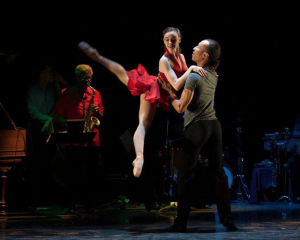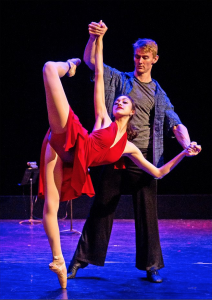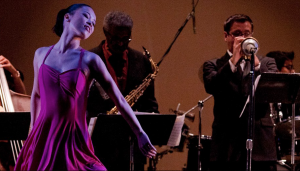Synergy is Sweet, Indeed, as San Diego Ballet Pirouettes to Live Jazz
Ballet, as practiced by San Diego Ballet, is a hybrid form, mixing classical steps, musical-theater pizzazz, and a desire to bring ballet to the people. As it says in the company’s program, “Our dancers dance anything and everything, as we strive to make our shows relatable to our Southern California audiences.”

Stephanie Maiorano and Shawn Burgess; Charles McPherson on sax.
And, while ballet purists won’t find this company at a brilliant technical level, artistic director Javier Velasco really knows how to deliver fun—for instance, “A Night of Jazz and Dance,” where dancers performed to live music by jazz virtuosi.
Shown last weekend at the Lyceum Theatre, “A Night of Jazz and Dance” featured two premieres set to original music by saxophonist Charles McPherson, “Reflection and Hope” and “Sweet Synergy Suite.” And McPherson led ensembles that included top artists from the local jazz scene: trumpeter Gilbert Castellanos, pianist Randy Porter, bassist Rob Thorsen, conga player Tommy Aros, and drummer Fernando Gomez.
They rocked “Sweet Synergy Suite,” an exuberant piece that opened with the dancers sitting, their backs to the audience, and facing the band as if they—and we—were at a club with a sizzling Latin combo. It was the first stop on a delicious musical journey that ranged from smooth, sophisticated moments to tense bongos to a movement with a Middle Eastern feel, and more.

Camille McPherson and Joe Hochschild in “Sweet Synergy Suite.”
The dance fun included a ballerina battle, Stephanie Maiorano and Ahna Lipchik taking turns showing off their moves. In a tender, young-love pas de deux, Camille McPherson and Joe Hochschild entered shyly from either side of the stage, and he supported her in adagio balances.
There was a thrilling “West Side Story” moment, two big groups entering from either side of the stage. Men partnered women. Women partnered women. Men partnered men. The women’s ponytails pranced! Shawn Burgess, in an acrobatic solo, radiated so much joy, I thought he was going to levitate.
Noriko Zaragoza provided a witty contrast, doing elegant balances as if untouched by all the commotion. (On Sunday, she made her final performance after eleven years as a San Diego Ballet dancer; she’s transitioning to ballet master.)
“Reflection and Hope” was a sort of chamber piece—for McPherson on saxophone and three string players, violinist Paivikki Nykter, cellist Cecilia Kim, and Thorsen on contrabass—that initially evoked a lonely street at two a.m., then shifted to a lighter, “it’s springtime” mood.
Velasco echoed the music’s intimacy by using just five dancers. And he featured Camille McPherson, who happens to be Charles’s daughter. In a charming moment, she danced with assured phrasing and killer extensions while her dad played a sax riff.
Hochschild, the one man in the cast, ably partnered the women and did a solo that I wish had been longer. Hochschild ran out, commanded the stage for a few seconds with his fluidity, power, and precision, and then it was over.

Noriko Zaragoza (photo from last year’s Jazz and Dance) did her final show on Sunday.
The show also included “Time Further Out,” set to some of Dave Brubeck’s experiments with time signatures, going from 2/4 to 9/4 (heard in recordings). Maiorano showed off quick, jazzy feet in the 4/4 section, and her pas de deux with Hochschild in 5/4 provided the most satisfying balletic moments in the program, with well-timed, dramatic lifts.
We also heard Brubeck’s iconic “Take Five” in a delightful educational prelude. Velasco came onstage and pointed out that, while ballet and jazz may seem an odd pairing, the pioneering jazz dance choreographer Jack Cole (a legend of Hollywood musicals) immersed himself in Bharata Natyam and started by doing Indian moves to jazz tunes. Then Velasco introduced dancers from North County’s Shalini Chauhan Nupoor Dance Academy, a group of some dozen graceful, gorgeously costumed girls who proved that, sure enough, Bharata Natyam works beautifully to “Take Five.”
I want to mention that San Diego Ballet did a smaller version of “Sweet Synergy Suite” a few years ago. This show marked the premiere of the fully realized piece, made possible by a San Diego Foundation Creative Catalyst grant. At a time when city funding for the arts is threatened with disproportionate cuts, and national arts funding may dry up entirely, it’s important to be reminded that when we, as a community, provide pennies for the arts, we get a wealth of benefits.

Award-winning dance journalist Janice Steinberg has published more than 400 articles in the San Diego Union-Tribune, Dance Magazine, the Los Angeles Times, and elsewhere. She was a 2004 New York Times-National Endowment for the Arts fellow at the Institute for Dance Criticism and has taught dance criticism at San Diego State University. She is also a novelist, author of The Tin Horse (Random House, 2013). For why she’s passionate about dance, see this article on her web site, The Tin Horse
